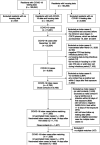This is a preprint.
Infectiousness of SARS-CoV-2 breakthrough infections and reinfections during the Omicron wave
- PMID: 36299430
- PMCID: PMC9603831
- DOI: 10.1101/2022.08.08.22278547
Infectiousness of SARS-CoV-2 breakthrough infections and reinfections during the Omicron wave
Update in
-
Infectiousness of SARS-CoV-2 breakthrough infections and reinfections during the Omicron wave.Nat Med. 2023 Feb;29(2):358-365. doi: 10.1038/s41591-022-02138-x. Epub 2023 Jan 2. Nat Med. 2023. PMID: 36593393 Free PMC article.
Abstract
SARS-CoV-2 breakthrough infections in vaccinated individuals and reinfections among previously infected individuals have become increasingly common. Such infections highlight a broader need to understand the contribution of vaccination, including booster doses, and natural immunity to the infectiousness of persons with SARS-CoV-2 infections, especially in high-risk populations with intense transmission such as prisons. Here, we show that both vaccine-derived and naturally acquired immunity independently reduce the infectiousness of persons with Omicron variant SARS-CoV-2 infections in a prison setting. Analyzing SARS-CoV-2 surveillance data from December 2021 to May 2022 across 35 California state prisons with a predominately male population, we estimate that unvaccinated Omicron cases had a 36% (95% confidence interval (CI): 31-42%) risk of transmitting infection to close contacts, as compared to 28% (25-31%) risk among vaccinated cases. In adjusted analyses, we estimated that any vaccination, prior infection alone, and both vaccination and prior infection reduced an index case's risk of transmitting infection by 22% (6-36%), 23% (3-39%) and 40% (20-55%), respectively. Receipt of booster doses and more recent vaccination further reduced infectiousness among vaccinated cases. These findings suggest that although vaccinated and/or previously infected individuals remain highly infectious upon SARS-CoV-2 infection in this prison setting, their infectiousness is reduced compared to individuals without any history of vaccination or infection, underscoring some benefit of vaccination to reduce but not eliminate transmission.
Keywords: COVID-19; Omicron; SARS-CoV-2; attack rate; correctional health; epidemiology; transmission; vaccination.
Figures




Similar articles
-
Infectiousness of SARS-CoV-2 breakthrough infections and reinfections during the Omicron wave.Nat Med. 2023 Feb;29(2):358-365. doi: 10.1038/s41591-022-02138-x. Epub 2023 Jan 2. Nat Med. 2023. PMID: 36593393 Free PMC article.
-
Risk and symptoms of COVID-19 in health professionals according to baseline immune status and booster vaccination during the Delta and Omicron waves in Switzerland-A multicentre cohort study.PLoS Med. 2022 Nov 7;19(11):e1004125. doi: 10.1371/journal.pmed.1004125. eCollection 2022 Nov. PLoS Med. 2022. PMID: 36342956 Free PMC article.
-
Infectious viral load in unvaccinated and vaccinated individuals infected with ancestral, Delta or Omicron SARS-CoV-2.Nat Med. 2022 Jul;28(7):1491-1500. doi: 10.1038/s41591-022-01816-0. Epub 2022 Apr 8. Nat Med. 2022. PMID: 35395151
-
Global trends in COVID-19.Infect Med (Beijing). 2022 Mar 4;1(1):31-39. doi: 10.1016/j.imj.2021.08.001. eCollection 2022 Mar. Infect Med (Beijing). 2022. PMID: 38074976 Free PMC article. Review.
-
Relative infectiousness of asymptomatic SARS-CoV-2 infected persons compared with symptomatic individuals: a rapid scoping review.BMJ Open. 2021 May 4;11(5):e042354. doi: 10.1136/bmjopen-2020-042354. BMJ Open. 2021. PMID: 33947725 Free PMC article.
References
-
- CDC. COVID Data Tracker. Centers for Disease Control and Prevention. Published March 28, 2020. Accessed June 9, 2022. https://covid.cdc.gov/covid-data-tracker
Publication types
LinkOut - more resources
Full Text Sources
Miscellaneous
